Unusual hardening mediated by {10–12} twins of strongly textured titanium at cryogenic temperature
IF 9.4
1区 材料科学
Q1 ENGINEERING, MECHANICAL
引用次数: 0
Abstract
{10–12} twinning is an important deformation mechanism for hexagonal metals; however, its characteristically low critical stress and resulting high twin activity often lead to rapid strain localization and premature failure. Therefore, this study aims to strategically delay {10–12} twinning at the initial deformation stage to prevent the strain localization, and concurrently seeks to reactivate {10–12} twinning at the large deformation stage to facilitate continuous hardening. Guided by these dual objectives, we selected rolled titanium as the model material and designed the loading direction to minimize the Schmid factor of {10–12} twinning, and then introduced cryogenic temperatures as low as 77 K to apply GPa-grade stress, thereby enabling continuous strengthening until the reactivation of {10–12} twinning. Under these specified conditions, the rolled titanium exhibited markedly enhanced mechanical properties; the ultimate strength increased from 618 MPa to 1634 MPa, while the true strain was increased by approximately 0.15 when the temperature was reduced from 298 K to 77 K. More importantly, an unusual strain hardening behavior was experimentally observed at a true strain of 0.16, at which {10–12} twins started to behave as the predominant twinning mechanism. Quantitative analysis further indicated that the large majority of the strain hardening capacity was attributed to high-density {10–12} twins. The present study therefore highlighted the pivotal role of {10–12} twins and offers a novel viewpoint for designing and achieving distinctive mechanical properties through the manipulation of deformation twinning.


在低温下,强织构钛的{10-12}孪晶介导了异常硬化
{10-12}孪晶是六方金属的重要变形机制;然而,其低临界应力的特点和由此产生的高孪晶活性往往导致快速应变局部化和过早失效。因此,本研究旨在在初始变形阶段有策略地延迟{10-12}孪晶,以防止应变局部化,同时在大变形阶段重新激活{10-12}孪晶,以促进连续硬化。在这两个目标的指导下,我们选择轧制钛作为模型材料,并设计加载方向以最小化{10-12}孪晶的施密德因子,然后引入低至77 K的低温施加gpa级应力,从而实现持续强化,直到{10-12}孪晶重新激活。在此条件下,轧制钛的力学性能得到了显著提高;当温度从298 K降低到77 K时,合金的极限强度从618 MPa提高到1634 MPa,而真应变提高了约0.15。更重要的是,在0.16的真应变下,实验观察到不寻常的应变硬化行为,此时{10-12}孪晶开始表现为主要的孪晶机制。定量分析进一步表明,绝大多数应变硬化能力归因于高密度{10-12}孪晶。因此,本研究强调了{10-12}孪晶的关键作用,并为通过变形孪晶的操纵来设计和实现独特的机械性能提供了一个新的观点。
本文章由计算机程序翻译,如有差异,请以英文原文为准。
求助全文
约1分钟内获得全文
求助全文
来源期刊

International Journal of Plasticity
工程技术-材料科学:综合
CiteScore
15.30
自引率
26.50%
发文量
256
审稿时长
46 days
期刊介绍:
International Journal of Plasticity aims to present original research encompassing all facets of plastic deformation, damage, and fracture behavior in both isotropic and anisotropic solids. This includes exploring the thermodynamics of plasticity and fracture, continuum theory, and macroscopic as well as microscopic phenomena.
Topics of interest span the plastic behavior of single crystals and polycrystalline metals, ceramics, rocks, soils, composites, nanocrystalline and microelectronics materials, shape memory alloys, ferroelectric ceramics, thin films, and polymers. Additionally, the journal covers plasticity aspects of failure and fracture mechanics. Contributions involving significant experimental, numerical, or theoretical advancements that enhance the understanding of the plastic behavior of solids are particularly valued. Papers addressing the modeling of finite nonlinear elastic deformation, bearing similarities to the modeling of plastic deformation, are also welcomed.
 求助内容:
求助内容: 应助结果提醒方式:
应助结果提醒方式:


